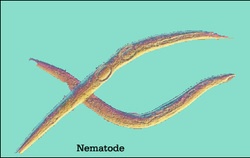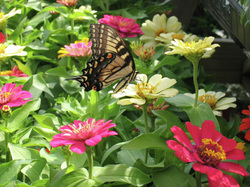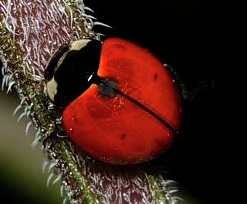Beneficial Bugs

Nematodes are slender, translucent, unsegmented round worms. Heberobabtios is a genus of nematode that is a natural predator. Beneficial nematodes feed on soil dwelling boring insects such as weevils, grubs, beetles, maggots, cutworms, fire ants, roaches, termites, fleas, and ticks. Nematodes control insect pests by entering thru the moth or body openings. Once inside the pest they feed and reproduce until the pest dies. Early application prior to heavy pest infestations followed by monthly follow-up applications is the ideal schedule when pest infestations are high. Nematodes can be applied in with a sprayer or as a direct soil drench. They are also present in small quantities in our Live Tea

Butterflies- They come in many shapes, sizes, and colors and inhabit all parts of Austin. Some common flutters are the Monarch, Swallowtail, and Painted lady.
Butterfly larva are caterpillars. Caterpillars enjoy living in the soil and feeding on plant matter. As caterpillars feed they grow and undergo metamorphosis with in a cocoon. During metamorphosis the caterpillar grows into a butterfly. After metamorphosis the butterfly has wings and is able to travel further for food. Adult butterflies can be seen eating the nectar of pentas, petunias, zinnias and many other flowers during spring, summer, and fall.
Attracting Butterflies
To attract butterflies and keep them visiting plant a variety of both host and nectar plants.
Host plants are species specific - attracting only the butterflies whose caterpillars will eat that plant. Nectar plants are flowering plants that provide pollen for butterflies.
Try to incorporate a variety of plants with a variety of heights and bloom times. Here are some samples of plants that Sledd Nursery carries that can be used to attract these butterflies and feed caterpillars.
Painted Lady - Daisy, Mallow, and Zinnia
Silvery Checker Spot -Sunflower Cosmos, Marigold, Phlox, Zinnia
Monarch - Buddleia
Zebra Longwing - Passion-vine, Verbena, Lantana,
Butterfly larva are caterpillars. Caterpillars enjoy living in the soil and feeding on plant matter. As caterpillars feed they grow and undergo metamorphosis with in a cocoon. During metamorphosis the caterpillar grows into a butterfly. After metamorphosis the butterfly has wings and is able to travel further for food. Adult butterflies can be seen eating the nectar of pentas, petunias, zinnias and many other flowers during spring, summer, and fall.
Attracting Butterflies
To attract butterflies and keep them visiting plant a variety of both host and nectar plants.
Host plants are species specific - attracting only the butterflies whose caterpillars will eat that plant. Nectar plants are flowering plants that provide pollen for butterflies.
Try to incorporate a variety of plants with a variety of heights and bloom times. Here are some samples of plants that Sledd Nursery carries that can be used to attract these butterflies and feed caterpillars.
Painted Lady - Daisy, Mallow, and Zinnia
Silvery Checker Spot -Sunflower Cosmos, Marigold, Phlox, Zinnia
Monarch - Buddleia
Zebra Longwing - Passion-vine, Verbena, Lantana,

Earthworms - Worms provide nutrients, improve the structure of the soil, and help other beneficial soil life. Earthworms help break up Austin's hard soil. They drill burrows that soak up fast falling rains, loosen the soil allowing for easier root growth. They digest harmful fungi, bacteria and help make soil nutrients available to plants. Earthworms are attracted to soils that are rich in organic matter and free from pesticides and harsh synthetic fertilizers.
Ladybugs : Ladybugs grow from eggs to adults in two to three weeks. Adults live several weeks to months. They feed on aphids and mites and other soft bodied insets. They live in vegetable crops, under rocks, leaves and other protected areas. Adults over winter and lay eggs in early spring. Females my lay from 200-1000 eggs during a three month period. Red, orange, yellow, white and green lady bugs can be found through out Austin gardens.
Ladybugs can be purchased in tins containing 2500 live ladybugs. They should be released at dusk after the garden has been thoroughly watered. Store lady bugs in the refrigerator until you are able to release them.
Ladybugs : Ladybugs grow from eggs to adults in two to three weeks. Adults live several weeks to months. They feed on aphids and mites and other soft bodied insets. They live in vegetable crops, under rocks, leaves and other protected areas. Adults over winter and lay eggs in early spring. Females my lay from 200-1000 eggs during a three month period. Red, orange, yellow, white and green lady bugs can be found through out Austin gardens.
Ladybugs can be purchased in tins containing 2500 live ladybugs. They should be released at dusk after the garden has been thoroughly watered. Store lady bugs in the refrigerator until you are able to release them.
